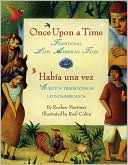Bilingual book of Traditional Latin American Tales that teach a whole heap of lessons!
 Martinez, Rueben.
Martinez, Rueben.Once Upon a Time/Habia una vez.
March 2010.
HarperCollins Publishers.
Review copy provided courtesy of publisher.
Within the pages of Once Upon a Time/Habia una vez, a bilingual book, readers can delight in the telling of seven traditional Latin American (originating in Cuba, Colombia, the Caribbean, Puerto Rico, northern Argentina, Andalusia, and Spain, as well as other areas in Latin America) tales:
- The Wedding Rooster/El gallo de bodas
- The Tlacuache and the Coyote/El tlacuache y el coyote
- The Mother of the Jungle/La Madreselva
- Marina the Cockroach and Perez the Mouse/La cucarachita Martina y el raton Perez
- The Flower of Lirolay/La flor de lirolay
- The King and the Riddle/El rey y la adivinanza
- Pedro Urdemales and the Giant/Pedro Urdemales y el gigante
This bilingual book is full of information relevant to Latin American culture. I don't typically see children picking this book up willingly, though, as it lacks illustrations that would likely engage them in the tales being told. If I were to use these tales with a group of preschoolers (or early elementary children), I'd likely need to create illustrations and/or felt board activities to coincide to keep their attention. However, that being said, the tales within are wonderful and there is much to be learned from each and every one of them!

If you're interested in finding out more information about any of the books reviewed or if you'd like to purchase the books, click the cover image for a link to Amazon.com. I am an Amazon Affiliate, so any purchases you make after clicking these images will result in my receiving a small percentage of the sale price!








0 comments:
Post a Comment